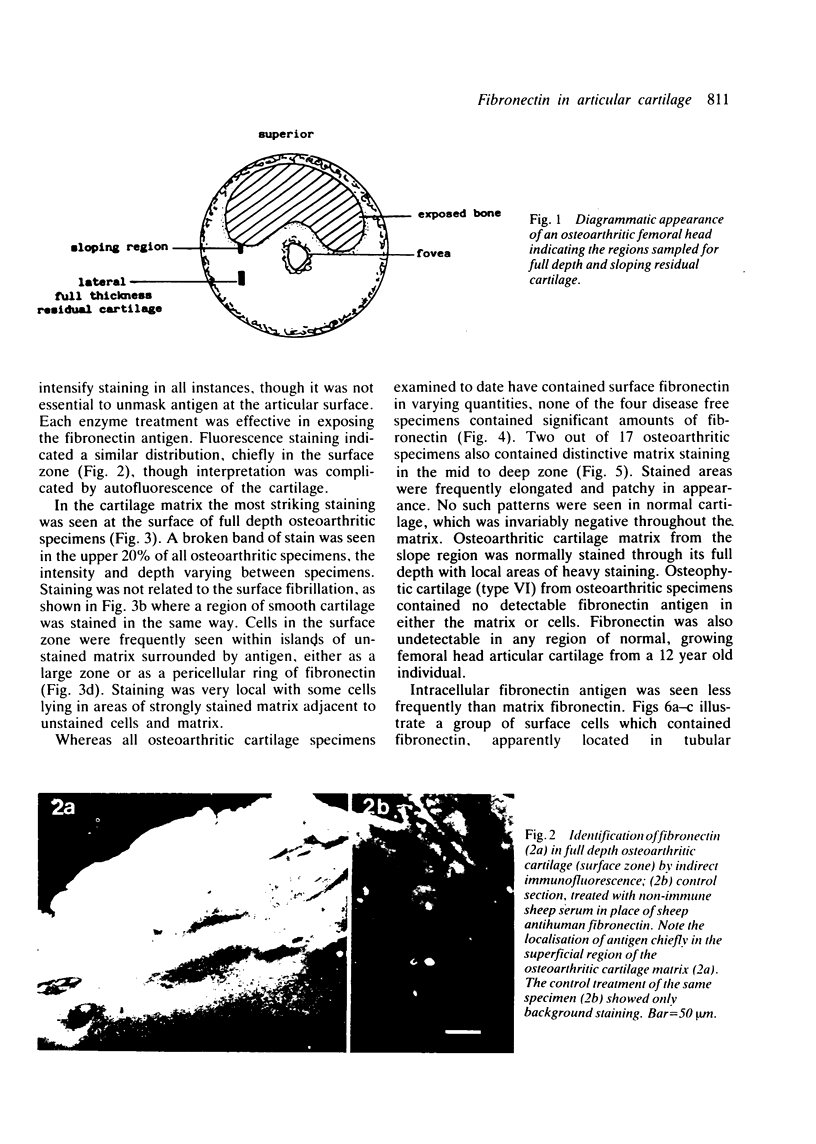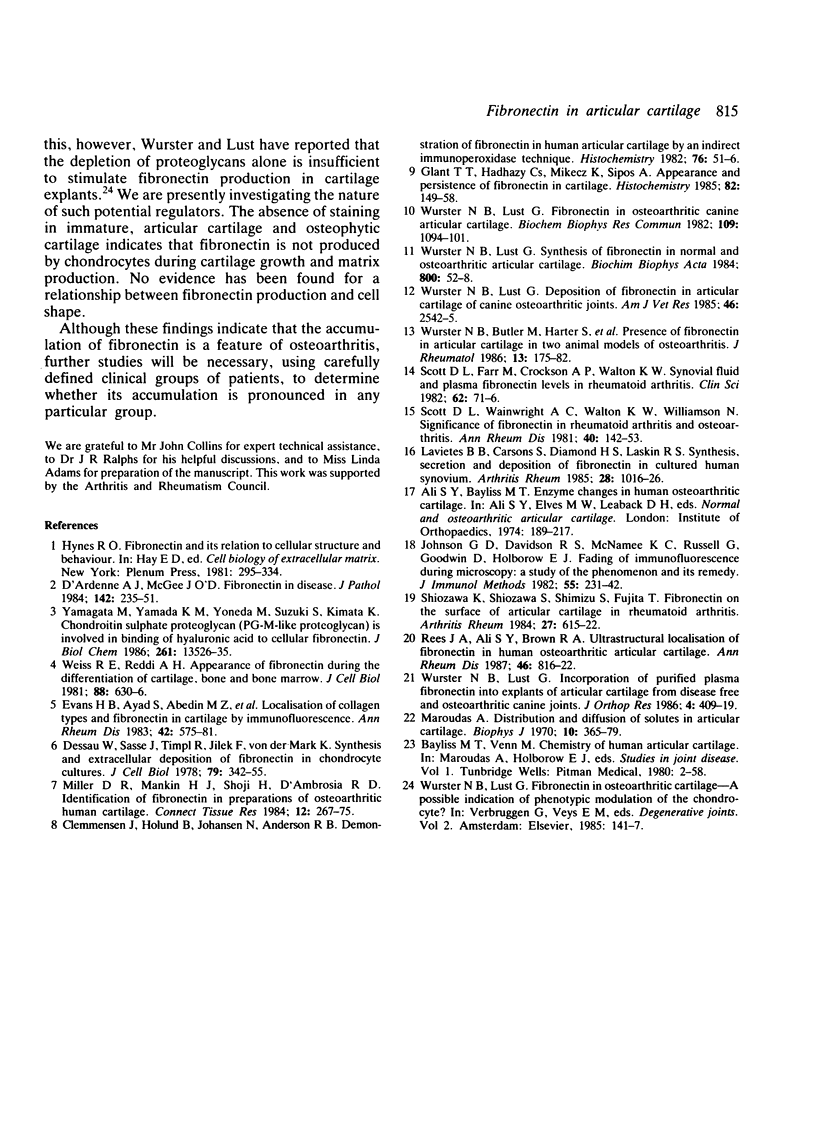Abstract
Fibronectin is a minor component of cartilage connective tissue matrix, which is reported to accumulate in increased amounts in osteoarthritis. The presence of raised levels of fibronectin in human osteoarthritic cartilage by immunoperoxidase localisation is confirmed. Residual femoral head articular cartilage from 17 patients with osteoarthritis contained variable but substantial amounts of fibronectin. This was localised mainly in a band within the matrix of the surface zone. No significant deposits of fibronectin were found in this or any other area of the normal specimens. Intracellular fibronectin was identified in some cells of the surface zone, indicating that it was, in part, synthesised locally. The presence and distribution of locally produced fibronectin in osteoarthritic cartilage suggest that its synthesis is a response by chondrocytes to changes in the cartilage matrix.
Full text
PDF






Images in this article
Selected References
These references are in PubMed. This may not be the complete list of references from this article.
- Burton-Wurster N., Butler M., Harter S., Colombo C., Quintavalla J., Swartzendurber D., Arsenis C., Lust G. Presence of fibronectin in articular cartilage in two animal models of osteoarthritis. J Rheumatol. 1986 Feb;13(1):175–182. [PubMed] [Google Scholar]
- Burton-Wurster N., Lust G. Deposition of fibronectin in articular cartilage of canine osteoarthritic joints. Am J Vet Res. 1985 Dec;46(12):2542–2545. [PubMed] [Google Scholar]
- Burton-Wurster N., Lust G. Incorporation of purified plasma fibronectin into explants of articular cartilage from disease-free and osteoarthritic canine joints. J Orthop Res. 1986;4(4):409–419. doi: 10.1002/jor.1100040403. [DOI] [PubMed] [Google Scholar]
- Clemmensen I., Hølund B., Johansen N., Andersen R. B. Demonstration of fibronectin in human articular cartilage by an indirect immunoperoxidase technique. Histochemistry. 1982;76(1):51–56. doi: 10.1007/BF00493284. [DOI] [PubMed] [Google Scholar]
- D'Ardenne A. J., McGee J. O. Fibronectin in disease. J Pathol. 1984 Apr;142(4):235–251. doi: 10.1002/path.1711420402. [DOI] [PubMed] [Google Scholar]
- Dessau W., Sasse J., Timpl R., Jilek F., von der Mark K. Synthesis and extracellular deposition of fibronectin in chondrocyte cultures. Response to the removal of extracellular cartilage matrix. J Cell Biol. 1978 Nov;79(2 Pt 1):342–355. doi: 10.1083/jcb.79.2.342. [DOI] [PMC free article] [PubMed] [Google Scholar]
- Evans H. B., Ayad S., Abedin M. Z., Hopkins S., Morgan K., Walton K. W., Weiss J. B., Holt P. J. Localisation of collagen types and fibronectin in cartilage by immunofluorescence. Ann Rheum Dis. 1983 Oct;42(5):575–581. doi: 10.1136/ard.42.5.575. [DOI] [PMC free article] [PubMed] [Google Scholar]
- Glant T. T., Hadházy C., Mikecz K., Sipos A. Appearance and persistence of fibronectin in cartilage. Specific interaction of fibronectin with collagen type II. Histochemistry. 1985;82(2):149–158. doi: 10.1007/BF00708199. [DOI] [PubMed] [Google Scholar]
- Johnson G. D., Davidson R. S., McNamee K. C., Russell G., Goodwin D., Holborow E. J. Fading of immunofluorescence during microscopy: a study of the phenomenon and its remedy. J Immunol Methods. 1982 Dec 17;55(2):231–242. doi: 10.1016/0022-1759(82)90035-7. [DOI] [PubMed] [Google Scholar]
- Lavietes B. B., Carsons S., Diamond H. S., Laskin R. S. Synthesis, secretion, and deposition of fibronectin in cultured human synovium. Arthritis Rheum. 1985 Sep;28(9):1016–1026. doi: 10.1002/art.1780280909. [DOI] [PubMed] [Google Scholar]
- Maroudas A. Distribution and diffusion of solutes in articular cartilage. Biophys J. 1970 May;10(5):365–379. doi: 10.1016/S0006-3495(70)86307-X. [DOI] [PMC free article] [PubMed] [Google Scholar]
- Miller D. R., Mankin H. J., Shoji H., D'Ambrosia R. D. Identification of fibronectin in preparations of osteoarthritic human cartilage. Connect Tissue Res. 1984;12(3-4):267–275. doi: 10.3109/03008208409013689. [DOI] [PubMed] [Google Scholar]
- Rees J. A., Ali S. Y., Brown R. A. Ultrastructural localisation of fibronectin in human osteoarthritic articular cartilage. Ann Rheum Dis. 1987 Nov;46(11):816–822. doi: 10.1136/ard.46.11.816. [DOI] [PMC free article] [PubMed] [Google Scholar]
- Scott D. L., Farr M., Crockson A. P., Walton K. W. Synovial fluid and plasma fibronectin levels in rheumatoid arthritis. Clin Sci (Lond) 1982 Jan;62(1):71–76. doi: 10.1042/cs0620071. [DOI] [PubMed] [Google Scholar]
- Scott D. L., Wainwright A. C., Walton K. W., Williamson N. Significance of fibronectin in rheumatoid arthritis and osteoarthrosis. Ann Rheum Dis. 1981 Apr;40(2):142–153. doi: 10.1136/ard.40.2.142. [DOI] [PMC free article] [PubMed] [Google Scholar]
- Shiozawa K., Shiozawa S., Shimizu S., Fujita T. Fibronectin on the surface of articular cartilage in rheumatoid arthritis. Arthritis Rheum. 1984 Jun;27(6):615–622. doi: 10.1002/art.1780270603. [DOI] [PubMed] [Google Scholar]
- Weiss R. E., Reddi A. H. Appearance of fibronectin during the differentiation of cartilage, bone, and bone marrow. J Cell Biol. 1981 Mar;88(3):630–636. doi: 10.1083/jcb.88.3.630. [DOI] [PMC free article] [PubMed] [Google Scholar]
- Wurster N. B., Lust G. Fibronectin in osteoarthritic canine articular cartilage. Biochem Biophys Res Commun. 1982 Dec 31;109(4):1094–1101. doi: 10.1016/0006-291x(82)91889-7. [DOI] [PubMed] [Google Scholar]
- Wurster N. B., Lust G. Synthesis of fibronectin in normal and osteoarthritic articular cartilage. Biochim Biophys Acta. 1984 Jul 16;800(1):52–58. doi: 10.1016/0304-4165(84)90093-x. [DOI] [PubMed] [Google Scholar]
- Yamagata M., Yamada K. M., Yoneda M., Suzuki S., Kimata K. Chondroitin sulfate proteoglycan (PG-M-like proteoglycan) is involved in the binding of hyaluronic acid to cellular fibronectin. J Biol Chem. 1986 Oct 15;261(29):13526–13535. [PubMed] [Google Scholar]













